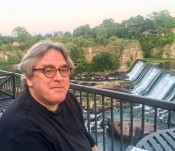Whitehot Magazine
September 2025
"The Best Art In The World"
"The Best Art In The World"
September 2025
Koho Yamamoto at Leonovich Gallery
 Untitled, n.d. Ink on paper. 23 x 17.5 in. Collection of the artist. Photo: Jaya Duvvuri
Untitled, n.d. Ink on paper. 23 x 17.5 in. Collection of the artist. Photo: Jaya Duvvuri
Koho Yamamoto: 101 Springs
April 15 through May 14, 2023
By JONATHAN GOODMAN, May 2023
Now a year or two beyond the age of 100 years, Japanese-American painter Koho Yamamoto, originally born on the West Coast, lives in a home for the elderly in Queens. Her excellent show, curated by her student Jaya Duvvuri, comprised a small retrospective of sumi paintings, a Japanese style that is very expressive, maintaining a similarity of form that, in Yamamoto’s case, might be called an abstract calligraphy. For many years Yamamoto ran an atelier downtown in Manhattan; her students are legion and acknowledge their fondness for her. During the course of her long life, Yamamoto faced the difficulties of Japanese-Americans during the Second World War. The artist lived in an internment camp in Utah for much of the war. There Yamamoto met noted painter Chiura Obata, an artist who taught her the skills that make her paintings so memorable. Yamamoto’s themes are traditional but the freedom of her brush has resulted in art of considerable spirit. Her efforts mostly embrace the landscape: bamboo, plum blossoms, pine trees. At the same time, her penchant for abstraction is never very far from the works in this show.
For nearly 35 years (1974-2010), Yamamoto taught from an atelier established on MacDougal Street, in Greenwich Village. She is a beloved teacher who passed on her skills to several generations of painters. If we look at the artist’s paintings, it is easy to see why: calligraphic strokes result in vibrant energies in service to lyric portrayals of nature and, usually, strong feeling presented abstractly. At the same time, Yamamoto, not an entirely devoted practitioner of Zen, counseled those in her classes to keep their mind “clear.” The merger of intention and the playful but disciplined strokes would result in a work of art both measured and free. This is evident from the start of the show, whose paintings are filled with enthusiasm and a liberated energy–likely the consequences of Yamamoto’s active and focused character.
 Untitled. ca 1990s. Ink on paper. 62 x 37 in. Collection of the artist. Photo: Alessandro Russino
Untitled. ca 1990s. Ink on paper. 62 x 37 in. Collection of the artist. Photo: Alessandro Russino
In one work, both untitled and undated, Yamamoto presents a work done entirely with ink on paper. It is a marvelous compilation of streaks and blots and line–a kind of abstract landscape. Two verticals, a thin line on the left and a thicker line on the right, with a few blots running up the line, begin with a tighter space between them at the bottom of the composition. But then, the lines widen, their gap increasing as they rise. Between them, close to the top are a small group of black orbs, while the background is mostly taken over by several horizontal washes of diluted ink. This piece like most in the show is characterized by an evident joy, making it emotionally memorable.
Another painting, entirely black on white, consists of a composition not unlike the energetic displays of Franz Kline. It consists of a mass of thick strokes centered in the painting, some of which extend outward beyond the center. Other broad strokes, rising and falling this way and that, take up the right and left areas of the painting. It is, like much of Yamamoto’s art, an exuberant work, full in keeping with both her training in traditional sumi art, as well as the inevitable influence of lyric abstraction that would come from her long stay in New York City. It might be hard to tell where the Japanese background might be found in this work, but the high energy, characteristic of Yamamoto’s output, makes the task of determining cultural specificity not truly needed.
 Untitled, c. 1987. Ink on paper. 34.5 x 44.5 in. Collection of the artist. Photo: Nicholas Knight
Untitled, c. 1987. Ink on paper. 34.5 x 44.5 in. Collection of the artist. Photo: Nicholas Knight
The last image to be described, a mysterious nocturne with a rounded moon high in the atmosphere, as well as a black mass, somehow birdlike, in the center right. There is some brightness in the upper register, but the bottom part appears to be covered with shadow–or a rolling landscape taken over by trees. Perhaps the reading of this work should equally emphasize its abstract implications, but we know from the show that Yamamoto moves easily from nature to the non-objective. Japan has always cultivated an encompassing relationship with nature, in its art especially, so it seems fair to look at the work in this way.
Yamamoto’s high-spirited energies, along with a very strong intuitive grasp of technique, made this show stand out as an example of fine Japanese art. While she was born here in America, her gift for sumi painting, conceived and developed in Japan, is unusual for its perception and skill. We are living in a time of esthetic merger, which means that cultural differences are being minimalized in favor of a shared internationalism. It is particularly exciting, then, to see Yamamoto find the depths of a culture she belongs to but did not grow up in–in a way that keeps a great tradition alive. WM

Jonathan Goodman
Jonathan Goodman is a writer in New York who has written for Artcritical, Artery and the Brooklyn Rail among other publications.
view all articles from this author









